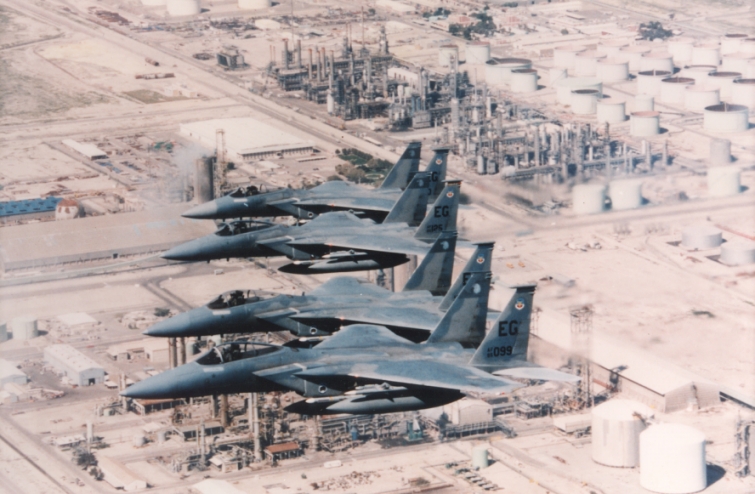
In this historic photo, a four-ship of F-15C Eagles, deployed from Eglin Air Force Base, fly over the Persian Gulf in the 1990s.
In early August 1990, Iraq invaded Kuwait to annex its rich oil reserves and offset Iraq’s growing debt from the Iraq-Iran war. President George H.W. Bush immediately ordered ground, sea and air forces to Southwest Asia as part of a multinational coalition to persuade Saddam Hussein to withdraw from Kuwait, an operation known as Desert Shield.
By the end of the month, the Nomads were on their way to King Faisal Air Base, Saudi Arabia with 769 personnel and 24 F-15Cs. This was the 33rd Tactical Fighter Wing (Provisional), a mini-version of the main 33rd TFW back in Florida. Commanded by Col. Rick N. Parsons, the 33rd TFW (P) recorded nearly 5,000 flight hours in over 1,700 training sorties in just four months.
Operation Desert Storm began Jan. 17, 1991 with an allied air attack over Baghdad. Capt. Jon K. “J.B.” Kelk scored the first aerial kill of the war, destroying a MiG-29 near Mudaysis, Iraq. Capt. Robert E. “Cheese” Graeter downed two Iraqi Mirage F-1s for the second and third kills of the war. Nomads continued their successes, when Capt. Rhory R. “Hozer” Draeger and Capt. Charles J. “Sly” Magill, a United States Marine Corps exchange officer, each destroyed a MiG-29 bringing the 33rd TFW (P) kills to five.
On Jan. 19, Capt. Richard C. “Kluso” Tollini and Capt. Lawrence E. “Cherry” Pitts downed a MiG-25 each. Meanwhile, Capt. Cesar A. “Rico” Rodriguez and Capt. Craig W. “Mole” Underhill each destroyed a MiG-29. This brought the total 33rd TFW (P) count to nine after only three days. On Jan. 26, Draeger and Rodriguez recorded their second kills for Desert Storm and Capt. Anthony E. “Kimo” Schiavi his first, all MiG-23s. Capt. David G. “Logger” Rose also destroyed a MiG-23 on Jan. 29, 1991. The wing’s final kills for Desert Storm occurred on Feb. 7, 1991 when Parsons destroyed one and Capt. Anthony R. “E.T.” Murphy destroyed two SU-7/17s.
In the three weeks since the start of Operation Desert Storm, the 33rd TFW (P) scored a total of 16 combat kills, the most of any allied unit. The Nomads also had the greatest number of pilots in one squadron with aerial victories (12), most pilots with multiple victories (4), and the only wing commander to record an aerial victory.
Beyond the achievements of the pilots, the success of the 33rd TFW (P) during Desert Storm relied on the hundreds of maintenance and support personnel who worked to ensure the planes and pilots were ready to fly. Mission capable rates averaged 95.6 percent during the first two weeks of the war, far above the Tactical Air Command standard of 83 percent. The total non-mission capable maintenance rate was .3 percent, well below the TAC standard of 12 percent.
Lt. Col. William Thiel, 58th Tactical Fighter Squadron commander, laid out the objectives before deploying: gain and maintain air superiority; kill ratio of XX to 0; no lost sorties due to operational or maintenance shortfalls. The 33rd TFW (P) achieved them all.
Operation Desert Storm’s 38-day air campaign ended on Feb. 23, 1991, and the famous “100-hour” ground campaign began the next day. Saddam Hussain ordered the withdrawal of all Iraqi forces from Kuwait and the war ended on Feb. 28. The conflict was the most decisive use of air power yet seen in American history, and the 33rd TFW (P) returned to Eglin Air Force Base on April 12, 1991.































